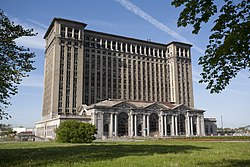Head house

The 18-story building was originally designed to host a hotel, rail company offices, restaurants, ticket halls and waiting rooms.
Head house is an American railroad term for the part of a train station which does not house the tracks and platforms. Outside America, the same part of a station is known as the station building. In the context of rail transport, the term head house usually refers to the portion of a large passenger terminal which contains the ticket counters, waiting rooms, toilets and baggage facilities. It might also include the passenger concourses and walkways between the platforms and other facilities.
Purpose
Larger terminals had amenities that were contained within their own distinct building which was separate to the railroad. For instance, when Cincinnati Union Terminal opened in 1933, the head house held a restaurant, lunch room, ice cream shop, news agent, drug store, small movie theater, men's and women's lounges, and restrooms that included changing rooms and showers.[1]
Subways
In the context of subways, a head house refers to the part of a subway station that is above ground, which may be nothing more than a covered entrance. The head house may contain escalators, elevators and ticket agents.
New York City and Boston

On the New York City Subway, a head house is referred to as a "Control House". They were built, and are still used in certain locations, where a simple staircase or kiosk was not desirable. During the design and construction of the IRT (opened 1904), control houses were as treated as integral architectural features of the system. In 1901, William Barclay Parsons, chief engineer for the New York Rapid Transit Commission, had traveled to Boston with Christopher Lafarge, where he was apparently inspired by the ornamental houses he saw used as entrances on the Tremont Street Subway.[2]
In response, architects Heins & LaFarge designed each IRT control house to be an attractive, exterior feature of the transit network system that was in keeping with its location. The buildings, which are examples of the Beaux-Arts style, are similar to other ground-level structures on the IRT, such as the powerhouses and sub-stations.
See also
- Grand Central Depot
- Reading Terminal
- Chicago Northwestern Station#History
- St. Louis Union Station
- Howrah station
- Newport (PATH station)
- Washington Union Station
References
- ^ "Cincinnati's New Union Terminal," Railway Age, Vol. 94, No. 16, April 22, 1938 (Available as a reprint — The Cincinnati Union Terminal — from the Cincinnati Railroad Club)
- ^ Framberger, David J. "Architectural Designs For New York's First Subway". Survey Number HAER NY-122, pp. 365-412. National Park Service Department of the Interior Washington, DC. 20240. Retrieved 26 December 2010.
